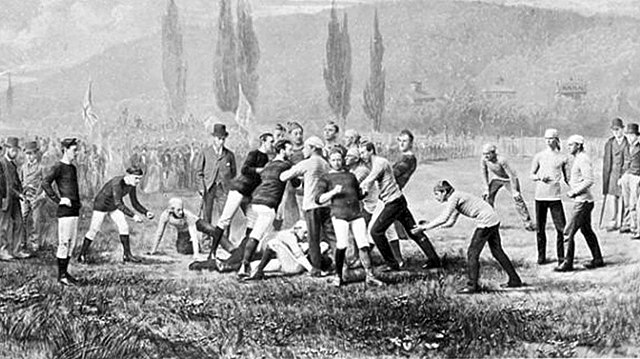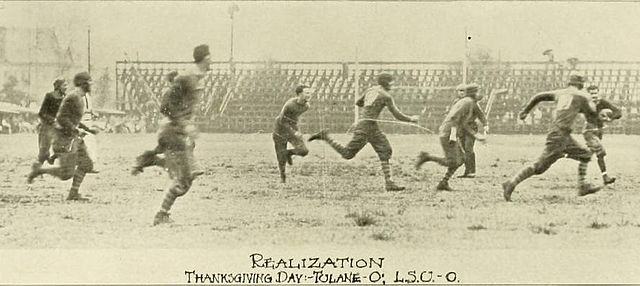American football’s humble beginnings were derived directly from the games of rugby and association football, so it is no small wonder that the original upper torso gear of the stocking cap era gridders was also the apparel of choice for rugby players as well.
The first collegiate game is recorded as taking place on November 6, 1869. In that contest, the College of New Jersey, ( now Princeton) and Rutgers played each other in a football match. The game was played using a round-shaped ball, and they used Football Association (soccer) rules but the style of play also had some hints of rugby. However, it was in fact much closer to soccer than what we know as American football as you were not allowed to carry the ball and could barely touch the ball with your hands.

An unknown artists rendition of the 1874 Harvard Crimson v McGill Redmen, game, courtesy Wikimedia Commons.
Not quite 5 years later on May 14 and 15, 1874 Harvard hosted a couple of pivotal matches versus McGill University from Canada. When the captains of the two teams met, however, their rules turned out to differ in several respects. The Canadian game allowed more carrying, and it used an oblong ball that was easier to throw and catch. So as a compromise they decided to play by Harvard’s more soccer-style one day and by McGill’s more rugby fashion the next. The Harvard players loved the Canadian game thus the two sports started a fusion of sorts.
The first jerseys of the gridiron were rugby-style tops with wool or cotton sweaters and no padding. Wool was chosen because the game was played outside in the frigid air of the Canadian provinces as well as the American North East. Players at that time needed to provide their own uniforms and equipment to play, which caused teams to have a wide variety of colors and uniform styles on the field. At the tail end of the 1800s, organizers and captains started coordinating their teams with dark-colored clothes made with thick, wool materials to protect themselves from impact and the harsh northern weather. But, these weren’t even similar to the protective and functional uniforms that players wear today.
The website OnwardState.com shares this about the early 1887 Penn State football team:
According to author Mark Harrington, Penn State players would give the balls to opposing players thinking they were on the same team. The Nittany Lions decided to pick matching colors for everyone to wear during games, and the team then chose to wear pink and black — Penn State’s original school colors.
As the rules of the game developed, players started donning padding. The material of choice was Leather because of its durability, pliability, and widespread availability. Leather patches represented the first uniform padding as they were sewn directly onto the wool sweaters for at least a bit of player protection.
As for numbers, Author Timothy P. Brown on his Fields of Friendly Strife website claims that American Football may have performed the numeral adornment as first in North America. Brown’s September 2021 article claims that Amos Alonzo Stagg thought about putting numbers on his University of Chicago players around 1900 but rescinded the idea when he worried that it would make the scouting of his players by opponents much easier. A Thanksgiving Day collegiate game in 1905 though between Iowa State and Drake did have unique numbers on the participants. The article says that the numbers were painted on pieces of canvas that had been sewn on the jersey back of each player in the game. 50 numbered shirts were provided with Drake using the first 25 and then Iowa State using the remaining number of 26 through 50.

Courtesy Wikimedia Commons, Photo during the 1914 Tulane University vs. LSU football game by an uncredited photographer.



